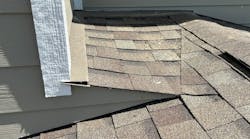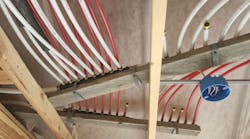5 Common Construction Mistakes
The trim is on, the site cleaned up. The tools are packed away. Few feelings are more rewarding than stepping back and looking at a job well-done.
But is that job really done well? Your crew may have fumbled some building basics without even knowing it.
The Partnership for Advancing Technology in Housing emphasizes practical, cost-effective building solutions that support your goal of selling more homes. With that in mind, read about these common mistakes in ductwork planning, home siting and building wrap.
If possible, always design ductwork to run through conditioned spaces. These ducts had to be run through the unconditioned basement, but properly sealing and having adequate insulation minimizes energy loss.The conventional method: Run ductwork through an unconditioned attic.
Job well-done: Either run ducts in conditioned space or insulate them really well in unconditioned space.
According to the NAHB Research Center, placing ductwork in conditioned space can reduce heating and cooling loads by 20 to 35 percent. It also reduces overall ductwork length because supply register locations are more flexible. Wrap ductwork in conditioned spaces with R-4 insulation to prevent condensation.
Joe Gregory, purchasing manager for Bob Ward Companies, recently built the near zero energy Maximum Efficiency Home series in Baltimore. He ran a duct-blaster test to show his crew how leaky the ducts were. Now he says his subcontractors understand the level of work required to in-stall ducts with 4 to 5 percent leakage rates, instead of the more typical 10.
The conventional method: Design the floor plan with no concern for site orientation.
Job well-done: Orient the home to take advantage of natural day lighting — and some free solar heating in the winter.
The benefits of natural lighting have been well-documented: people work better, students learn better, and people are healthier in general. And designing a daylit home needn't add expense to your projects.
In all but the hottest southern climates, orient the building so the long axis runs east to west. Place a row of windows along the south wall for winter gain. Size roof overhangs to block the summer sun, but let in light and warmth from the winter sun. Cluster the main living areas along the south wall and mechanical and storage areas to the north.
Skylights are energy hogs that can make a room uncomfortably hot. Try sun tubes, or tubular skylights, to bring light into dark corners, interior rooms, or even the basement without as much energy loss.
What we see: A housewrap seam flapping in the wind, with a 2-inch overlap.What we should see: The top roll should overlap the bottom by 6 inches, and the seam should be taped.
The conventional method: Put building wrap up as quickly as possible, and don't worry about tape or careful installation.
Job well-done: Follow the manufacturer's instructions.
When you get this wrong, you risk mold and mildew; rotting window jams; and drafty walls and floors.
To get it right, overlap all seams at least 6 inches in shingle fashion so they shed water. Seal with code-approved contractor sheathing tape to make a weather tight bond. Use proper fasteners (plastic cap nails are the best), and make inverted Y cuts (also called modified I cuts) to wrap window openings.
